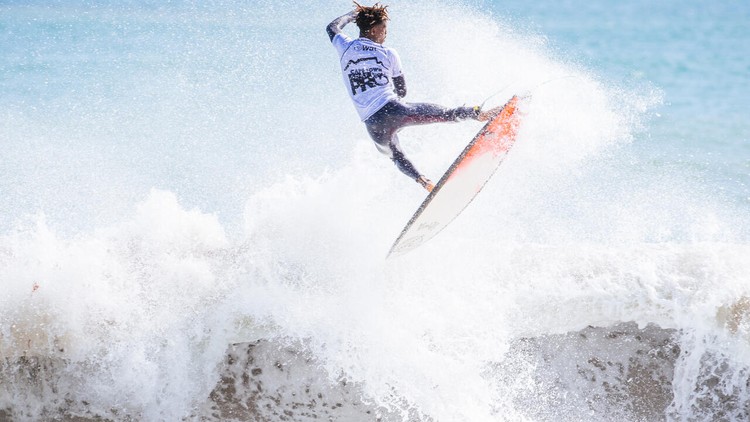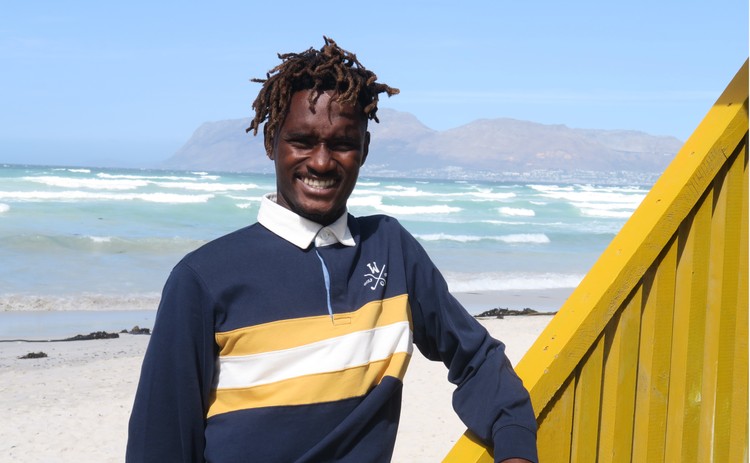Former street kid steps onto the global surfing stage
Capetonian Paul Sampson has battled seemingly insurmountable odds to compete with the best in the world
Cape Town surfer Paul Sampson in the midst of his winning manoeuvre at the Cape Town Pro surfing competition in Kommetjie on 17 March. Photo: WSL/Kody McGregor
-
Following a win at a World Surf League qualifying event in Kommetjie last month, Sampson is ranked joint number one in Africa.
-
He is currently the only black African surfer to make it into the prestigious WSL Challenger Series which starts in Australia on 27 April.
-
People in the surf industry say getting as far as Sampson has is very difficult even for well-resourced competitors, but Sampson has the talent and dedication to surf against the world’s best.
A formerly homeless Cape Town surfer, who was orphaned in his early teens, has overcome daunting personal, economic, and logistical obstacles to come within reach of competing on the international stage.
Paul Sampson, who was dogged by poverty and spent part of his early childhood in landlocked Kimberley before moving back to Cape Town, shot up the competitive surfing rankings when he won the Cape Town Surf Pro competition at Long Beach, Kommetjie, on 17 March, after coming in on a wild card ticket.
The win meant Sampson, who for a while lived in caves on the Muizenberg mountain with his late mother when he was a child, earned enough points to catapult him into the World Surf League’s (WSL) Challenger Series.
Only the top four surfers from Africa make it into the Challenger Series, which is the launchpad to the WSL’s prestigious Championship Tour – the peak of professional surfing where 35 of the world’s best surfers compete at iconic breaks around the globe to be crowned world champion.
Getting within sight of the Championship Tour is daunting even for well-resourced surfers in South Africa.
Paul Sampson, 24 years old, stands on the brink of an international professional surfing career. Photo: Steve Kretzmann
Surf journalist and author Steve Pike said being able to accumulate the points needed to get seeded at the top of the Qualifying Series didn’t just mean getting good results at competitions, it also meant finding the means to travel to competitions across the country, and afford the entry fees, which were in dollars.
Then if you got into the Challenger Series, to have a shot at the top-tier Championship Tour, you needed to have surfed at least four of the six competitions in the season, only one of which was in South Africa, at Ballito, KwaZulu-Natal. This was partly why, despite South Africa’s surfing talent, there were only two South Africans on the Championship Tour. But with Sampson having come this far, and with his talent, “the world is his to take”, said Pike.
Sampson said his love affair with the ocean, which started when he first saw it at about the age of six, was supported by numerous local surfing development programmes.
Speaking at a coffee shop on Muizenberg beachfront where he first fell in love with surfing, 24-year-old Sampson, who lost contact with his Zimbabwean father when he was still a child, said that when they arrived from Kimberley they stayed with his brother’s father while his mom looked for a job. It was then, when he was about six and a half years old, that he took part in the Palama Metsi Surfing Development Academy in Muizenberg.
“The first time I encountered going into the ocean, I was hooked,” he said. “I fell in love with the sport.”
But it wasn’t long before he was living rough with his half-brother, his mom, and her boyfriend. Standing on the beachfront, he was able to point out the overhang they lived under, also mentioning a cave on the slope above the Muizenberg police station.
His mom, whom he says didn’t smoke and rarely drank, earned money as a car guard, making enough at Muizenberg’s Sunrise Circle market on Sundays to get them through the week. Although he can’t remember the year, he said it was two weeks before Christmas when his mom died of kidney failure. “Living outside took its toll.”
After that he and his half-brother stayed with various family members on his brother’s side, moving between areas such as Lavender Hill and Capricorn. He was also sheltered for a while by a local woman before the Chudleighs, who run Surfshack Surfschool in Muizenberg, fostered him.
Dave Chudleigh said they fostered Sampson from the age of nine until he turned 18 and decided to forge his own path. Chudleigh said Sampson had attended Muizenberg Junior school but due to his circumstances had difficulty progressing, so they helped him with homeschooling.
With a secure home environment, Sampson entered Western Province Surfing’s Grom Games (grommet is surf slang for child) and made the under-10 and then the under-11 team.
“That showed me a lot, how I felt about the sport. It made me feel like myself, like I can express myself,” he said.
Sampson has continued to enter local, and some international competitions such as in Sri Lanka last year, where he worked at a surf camp in order to win prize money.
He is often found at Muizenberg volunteering with the Cass Collier Surf Foundation. At the foundation he helps teach trauma-affected girls from Bonteheuwel and Hanover Park to surf and enjoy the ocean. He also earns money by offering private surf lessons.
Collier competed in what was the equivalent of today’s Championship Tour from 1989 to 1991 despite struggling under the apartheid colour bar, and was Reef ISA 1999 World Big Wave Champion along with fellow Capetonian Ian Armstrong. He is now Sampson’s coach.
Sampson said his partner, Micaela Walker, their two-year-old daughter Moana, Collier and Eli (Collier’s son), along with the “big” Walker family, are his strength and support. He said he would not be able to enter the tough global professional circuit without them.
“The WSL [World Surf League] is heavy. Mentally you have to be on-point. You have to be mad, as in a sports way, to push through.”
But, he said, to succeed on the international tour might help a lot of disadvantaged young people find inspiration.
“We want more black people to get opportunities. [We] want a voice for the youth, to show them they can make it. You’ve just got to get your mind in the right space and know what you want. And it helps if you can find your [support] circle.”
According to Collier, just getting to Qualifying Series competitions such as the South African Open of Surfing in Gqeberha, where he added crucial points by making it to the quarter-finals, stretched their resources, and the first stop on this season’s Challenger Series is in Australia on 27 April, and a support crew needs to go along.
“I travelled on the world tour alone. It’s difficult. Other surfers (on the tour) told me you can never do it on your own,” said Collier. “I don’t want him to face that.”
As the only black African on the tour from an underprivileged background, there was a lot of pressure on Sampson’s shoulders, said Collier. However, Sampson was “unbelievable under pressure,” he said.
WSL Africa director Tasha Mentasti said she’d watched Sampson come through the development ranks with Surfing South Africa and recognised his talent. Mentasti said it was because of his “ability and potential” that the WSL gave him a wildcard entry into the Cape Town Surf Pro where his win shot him up the ranks.
She said he was one of ten surfers WSL had recognised under their talent programme, and while the WSL could not help with finance for the tour, the office did help with administrative issues such as visas and “decisions that are beneficial”.
“He’s got the potential to inspire,” she said.
Sampson said the journey has not been easy – “it’s been a rollercoaster”. But he felt blessed that he was still surfing. “I’ve met a lot of kids who went off and became gangsters. They’re from heavy areas. That could have been me. Many of those kids could have excelled in academics or sport.”
Support independent journalism
Donate using Payfast

Don't miss out on the latest news
We respect your privacy, and promise we won't spam you.
Next: Medical workers protest against attacks on them
Previous: Ingonyama Trust finances are not transparent, says report
© 2024 GroundUp. This article is licensed under a Creative Commons Attribution-NoDerivatives 4.0 International License.
You may republish this article, so long as you credit the authors and GroundUp, and do not change the text. Please include a link back to the original article.
We put an invisible pixel in the article so that we can count traffic to republishers. All analytics tools are solely on our servers. We do not give our logs to any third party. Logs are deleted after two weeks. We do not use any IP address identifying information except to count regional traffic. We are solely interested in counting hits, not tracking users. If you republish, please do not delete the invisible pixel.


